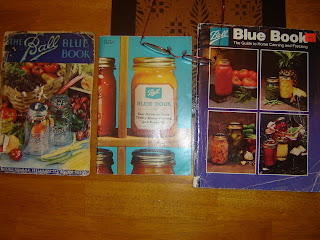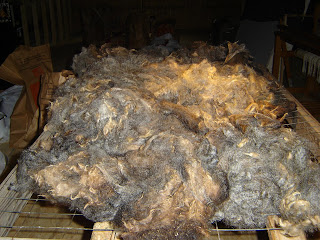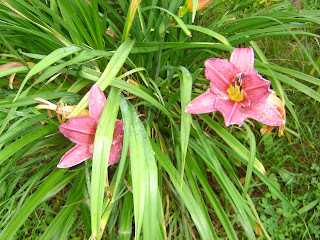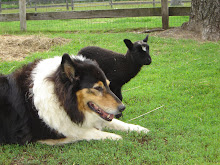 We have two hives of bees. This was a new venture for us last year. DH is the beekeeper, but I do have a genuine interest in them and their incredible value to the farm. We started with a borrowed hive last year. Friends had a hive that needed a home once it was moved from the apple orchard and we were happy to have it here for a season. This spring, before they opened it, they moved it to a new location and we put up our own hives. We purchased all the parts for two hives. They needed to be put together and painted. I can remember growing up bee hives were always white. Now it is recommended to paint them darker colors. We chose the green to match the roof of our house.
We have two hives of bees. This was a new venture for us last year. DH is the beekeeper, but I do have a genuine interest in them and their incredible value to the farm. We started with a borrowed hive last year. Friends had a hive that needed a home once it was moved from the apple orchard and we were happy to have it here for a season. This spring, before they opened it, they moved it to a new location and we put up our own hives. We purchased all the parts for two hives. They needed to be put together and painted. I can remember growing up bee hives were always white. Now it is recommended to paint them darker colors. We chose the green to match the roof of our house. squash blossom with busy bees hard at work
squash blossom with busy bees hard at work 10 foundations in a super
10 foundations in a superThe second super or box is where the bees make honey that they will store and live on this winter. Our bees, so far are doing a great job of this. We have a wonderful supply of clover, goldenrod, and of course, garden produce that the bees have been working and the honey combs show this.

Foundation covered with bees and honey comb full of capped honey

small foundations we added to the third super for extra honey harvest

Smoking the bees
As a rule, DH checks the bees and does whatever is necessary. I watch from a distance. I'm not terribly afraid of them but I have a healthy respect for thousands of bees swarming around my head! He really loves this and wanted to share the experience with me so I agreed to put on a marshmallow suit and check it out.
To open the hives, he removes the cover and he uses a smoker which has baling twine and newspaper in it. The little bellows keep the fire going and creates the smoke. The smoke stimulates the bees to gorge themselves on honey and therefore keep them from stinging us. We open one hive at a time.
 Opening the hive
Opening the hiveSteve isn't as apprehensive as I am and doesn't normally use his face protection. I on the other hand, went in with full outfit from head to toe. I wasn't taking any chances :)
Not taking any chances!



 We added another 6 ton to the upper hay barn and it is full to the brim. We couldn't get another bale up there no matter how hard we pushed! We put these round bales up through the front doors with the tractor and then roll them down through the barn. The left side is filled with squares, the right with rounds.
We added another 6 ton to the upper hay barn and it is full to the brim. We couldn't get another bale up there no matter how hard we pushed! We put these round bales up through the front doors with the tractor and then roll them down through the barn. The left side is filled with squares, the right with rounds.





 A very proud, much happier and less hairy Tyler :)
A very proud, much happier and less hairy Tyler :)





 Kelsey, Tyler & Tom
Kelsey, Tyler & Tom My second box of peaches arrived and I'm chomping at the bit to get them processed. I'm hoping either this evening or tomorrow afternoon. I'm going to try freezing some of them as recommended by a fellow blogger.
My second box of peaches arrived and I'm chomping at the bit to get them processed. I'm hoping either this evening or tomorrow afternoon. I'm going to try freezing some of them as recommended by a fellow blogger. 





 Two naughty shetland ewes in the feeder ~
Two naughty shetland ewes in the feeder ~ I separate the cream from our milk on Monday, Wednesday and Friday mornings. Milk dishes take me longer as the cream separator has many parts. I was finished chores and cleaned up by 10 a.m. It was such a beautiful morning Mom and I decided to take an hour or so and go pick blueberries. We are fortunate to have Libby & Son about 15 minutes from the house.
I separate the cream from our milk on Monday, Wednesday and Friday mornings. Milk dishes take me longer as the cream separator has many parts. I was finished chores and cleaned up by 10 a.m. It was such a beautiful morning Mom and I decided to take an hour or so and go pick blueberries. We are fortunate to have Libby & Son about 15 minutes from the house.


 The picking was plentiful and easy. We picked about 30 pounds of berries. We packaged most of them in quart bags for the freezer and will use them this winter. I left a large bowl in the fridge to enjoy on cereal or in yogurt. Sunday mornings we have a family breakfast after chores. This week it will be blueberry pancakes, our pork sausage, fresh eggs and Maine maple syrup. Can't wait!
The picking was plentiful and easy. We picked about 30 pounds of berries. We packaged most of them in quart bags for the freezer and will use them this winter. I left a large bowl in the fridge to enjoy on cereal or in yogurt. Sunday mornings we have a family breakfast after chores. This week it will be blueberry pancakes, our pork sausage, fresh eggs and Maine maple syrup. Can't wait! Miles and Tyler at the blueberry field
Miles and Tyler at the blueberry field Orange poppy
Orange poppy



 south pasture road
south pasture road not a pond but my new pasture
not a pond but my new pasture
 The hateful hornworm
The hateful hornworm The wild blueberries and blackberries are plentiful as well as lots of greenery for the deer and other wildlife to enjoy.
The wild blueberries and blackberries are plentiful as well as lots of greenery for the deer and other wildlife to enjoy.















